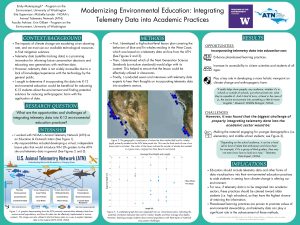Modernizing Environmental Education: Integrating Telemetry Data into Academic Practices
Telemetry data is an increasingly useful resource for analyzing the impacts of climate change on the environment and animal populations. However, in order for telemetry data to become more accessible to both environmental stewards and the general public, it must be properly integrated into environmental education practices. During my time with NOAA’s Animal Telemetry Network (ATN) as an Education & Outreach intern, I seeked to establish: (1) The main benefits of integrating telemetry data into K-12 academia, and (2) How to most effectively incorporate this data into environmental education practices and curricula. I accomplished this during my internship by developing a virtual, independent lesson plan that was designed for 9th-12th grade students. Additionally, I interviewed 7 telemetry data experts employed with my host organization. With this information, combined with scholarly research, I found that the main challenge of integrating telemetry data into academic instruction would be engaging younger audiences with the material. However, the benefits of this implementation far outweigh the drawbacks, as it has the potential to enhance place-based learning methods, which are proven to foster environmental stewardship in students. Furthermore, the visualization capabilities of telemetry can be combined with other forms of data to create a more holistic perspective on climate change and anthropogenic harm. In summary, this is a significant issue to address because telemetry data can only be utilized to its greatest extent if we make an active effort toward teaching the future generations of students about proactively applying this data toward developing climate change mitigation solutions.
